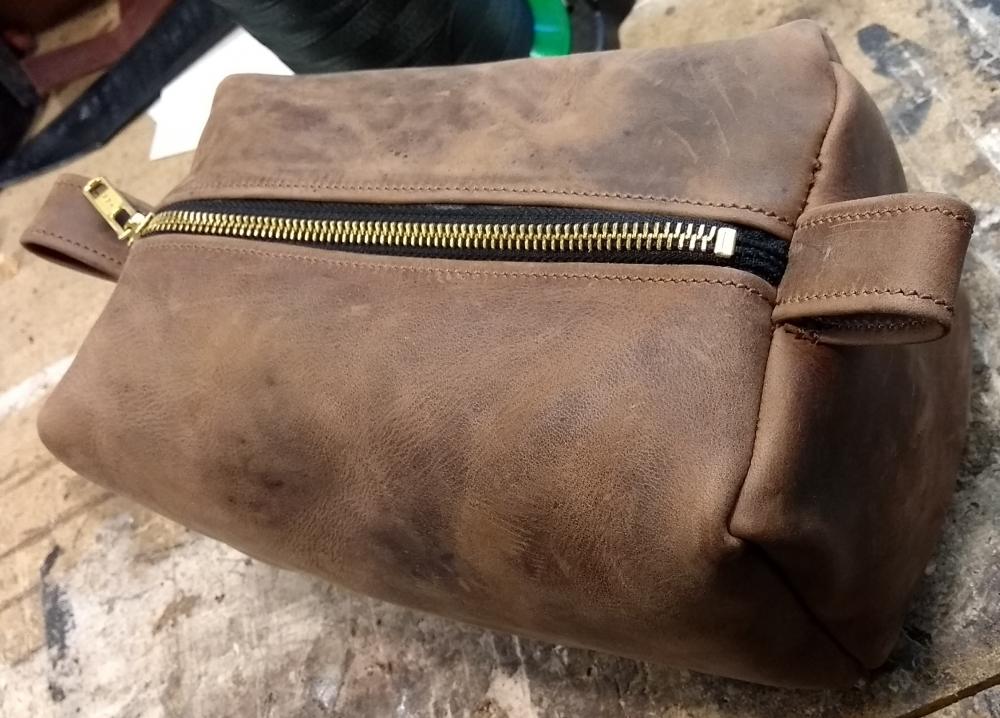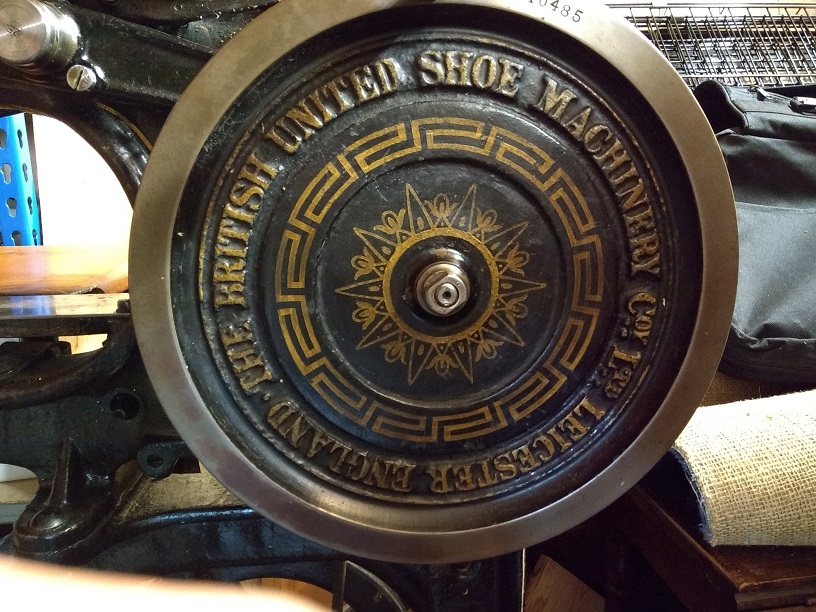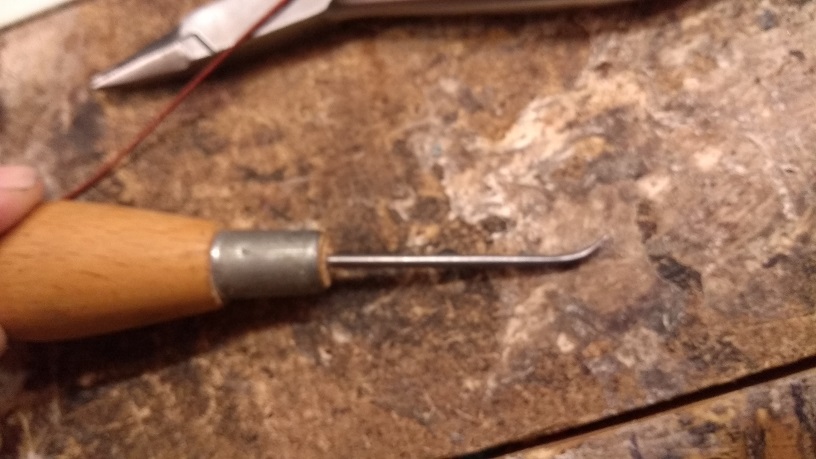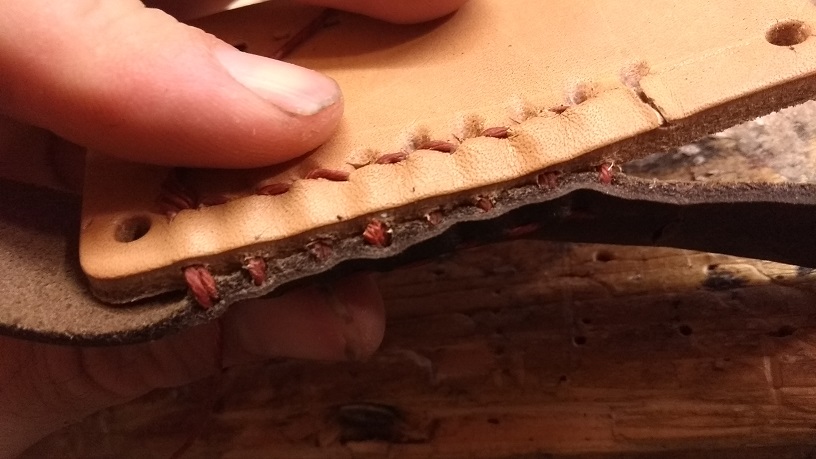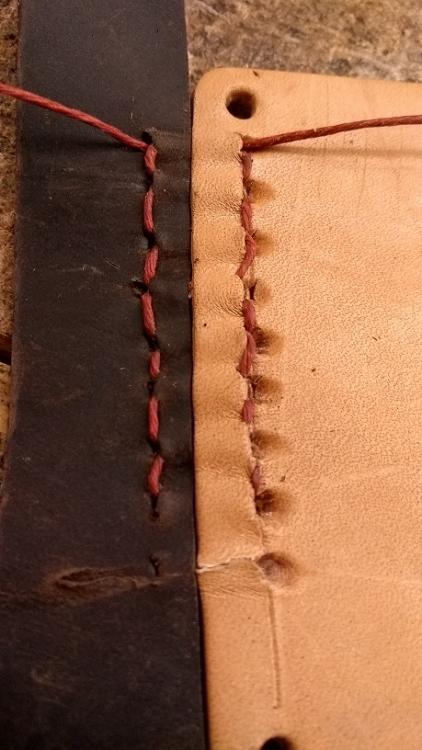-
Posts
1,806 -
Joined
Content Type
Profiles
Forums
Events
Blogs
Gallery
Everything posted by Matt S
-

cobra sewing machine Cobra C3 - Thread options?
Matt S replied to entropie's topic in Leather Sewing Machines
Ya don't want to, ya don't want to. Wax isn't difficult to deal with but it's more hassle than I think is worth it for a roll of TKT40 poly.- 13 replies
-
- braided plyester
- nylon thread
- (and 7 more)
-
Le Prevo used to make leather stuff then moved into selling supplies, I think, so they may well have some sort of splitter. I didn't realise you were using tooling leather, I think I have some in various thicknesses. Let me check and get back to you. If you mean stamping like tooling, it's not much my thing so I've never tried on bridle. Bridle leather can absorb water with a little work (certainly enough for a crisp turnback, or for some wet moulding) but due to the amount of tallow/grease/wax I think it won't every be as toolable as proper tooling leather. Bridle takes stamps like embossing plates just fine dry, either cold with a lot of pressure and several seconds' dwell time or heated with less pressure and dwell. It also takes a hot crease well. The 4mm butts I buy are more like a "belt butt" or "mini butt" than a proper saddlery butt -- average about 48" long though obviously this varies from piece to piece. "Normal" butts are about 60" -- great for horse applications but wasteful for trouser belts unless you're Mr Creosote.
-

Interesting old YouTube Video - Saddlers in Ireland
Matt S replied to jcuk's topic in Saddle & Tack Maker Gallery
Hi JCUK, Thanks for the explanation, very clear and informative! -

cobra sewing machine Cobra C3 - Thread options?
Matt S replied to entropie's topic in Leather Sewing Machines
Yeah could be. In the context of a boot factory likely your roll of thread will have been run through a machine setup for one particular job, day in day out. The inconvenience and mess of a lubed thread wouldn't have mattered very much compared with whatever advantage it conveyed. If you don't want to lube it I understand -- a 3Km king spool of TKT40/v69 is what, £10? That's a cheap price for avoiding a lot of mess.- 13 replies
-
- braided plyester
- nylon thread
- (and 7 more)
-
In my experience sheepskin (often called nappa or basil) seems to always be a bit too short for lining belts. Pigskin tends to be larger, not very expensive per foot and readily available, though usually only in chrome tannages (don't know if that floats your boat or not). Of course there are plenty of calf and cow leathers available, suitable for the purpose. I rarely see anything other than bridle or similar 3+mm leather sold as a strip so you'll probably have difficulty buying anything specifically for lining unless you're willing/able to pay for a bigger bit of leather. My double layer belts tend to be "equal", i.e. lined with a second layer of what the top is made from, but this is probably not so suited to a dress belt. Where are you buying your strips/straps from? Perhaps the vendor can split them for you? If you were nearer I'd say come over for a cuppa and use my splitter. Is there someone nearish you who might have a splitter they'll let you use? If you let me know more specifically what you're after (colour etc.) I can have a look through my stock and see what I have that might suit you. I have a crank splitter that I can usually persuade to take 4mm bridle down to 2, or if not I regularly have access to a 12" band knife splitter that can be has a tenth of a millimeter accuracy. You can fit a lot of coiled up belt blanks in a £3 RM small parcel! Longer-term, Abbey England sells a 2.5mm bridle butt. It appears to be very similar to their 4mm Italian bridle, which I use a fair amount of. I realise it's probably more than you might want to invest in a piece of leather at this point but they are a very reasonable price for the quality. No need to buy a whole side, these belt-length butts are about 10SQFT. I I've had one of the 2.5s on backorder for a month, I'll let you know what it's like when it comes in.
-

Interesting old YouTube Video - Saddlers in Ireland
Matt S replied to jcuk's topic in Saddle & Tack Maker Gallery
Great find JCUK! I'm no saddler but found it a fun watch while pretending to work. Great to see a BUSM/Pearson #6 "in the wild" as it were (and a few seconds of a Singer 132K I think). First time I've seen a linen thread being rolled by hand too. Read about it as much as I could find and practiced it an awful lot but that chap makes it look as natural as falling off a log. Never seen reins sewn directly onto a bit ring either -- only ever looped on, or attached via a buckle or hook stud. Never in my years as a hobby rider, as a groom or in any of the old books I have. Anyone know if this is a local thing (maybe even to that particular saddlery) or more widespread than my limited experience allows me to know? Would certainly make cleaning the bit tricky, and changing the bit require a trip to the saddler. -

cobra sewing machine Cobra C3 - Thread options?
Matt S replied to entropie's topic in Leather Sewing Machines
Is your braided thread dry or lubed in some way? I have some dry braided poly thread that only started working reliably through my #6 when I started waxing it. I think the braid was opening up just enough to catch on the shuttle point. I've had mixed results with braided thread in machines, which echoes yours -- will often work for a short time, then suddenly the hook will catch the middle of the thread and bad things happen. I have had some success running "hand sewing" thread through machines -- my #6 harness machine, my 45K and an outsole stitcher I used to have, but these were all designed from the ground up to run large threads. (twisted linen from 18/3 up to 18/7 and tiger thread over 1mm). @entropie Ritza do a thread designed specifically for machine sewing, which is lubed with silicone rather than wax. I've never tried it (mainly use twisted nylon or poly) but that may work better in your Cobra. It's also available through Abbey.- 13 replies
-
- braided plyester
- nylon thread
- (and 7 more)
-

Alternative to Gum Trag
Matt S replied to Russ498's topic in Dyes, Antiques, Stains, Glues, Waxes, Finishes and Conditioners.
Almost any water-soluble glue or gum will work as an alternative to tragacanth -- Arabic gum, pearl/hide/rabbit/bone glue, those gum pens that kids use for gluing ugly bits of paper to larger bits of paper in school, even PVA. Glycerin soaps (e.g. saddle soaps) will also help to wet the fibres and lubricate your burnishing tool though I don't find that they . However they will all resist dye to an extent if you get it on the front. -
I have a clutch motor on my skiver. There is, as others have mentioned, a brake which impinges on the output pulley when the pedal is fully released but releases with just a light touch on the pedal. @medion if you switch the motor off and press the pedal a little, does the "stiffness" disappear?
-
Got a picture of the Ferdco? I understand that "back in the day" Ferdco was hotrodding genuine Juki 441s to make the 2000. If that's the case, assuming minimal wear and damage, its worth would probably exceed a new-out-the-box Cobra or other 441 clone. Parts would also be easily acquired and as to support, well you'd have to pony up for a skilled technician to fix anything you can't. Same as buying a used car.
-
I use 2mm medium-temper heavily waxed chrome-tan for these wash bags. That's about 5oz. Still technically at the prototyping stage as I'm only 90% happy with the result. They're pretty difficult to do in this leather, even having skived all the edges. Softer leathers are definitely easier -- I made one in CF Stead repello, which is the same thickness but a much softer temper. Far easier, both to sew and to turn.
-

Can somebody ID this machine please ... No. 2.
Matt S replied to Rockoboy's topic in Leather Sewing Machines
Checked my paper BUSM catalogue and there's no patcher/elastic machines in that edition either. Here's a photo of the pinstriping on the wheel of my BUSM #6. There's a definite resemblance I think. Whether that means the patcher is a BUSM manufactured machine, a bought-in/rebadged machine sold by BUSM, a Pearson machine (the predecessors to BUSM) or someone just imitating the BUSM style of pinstriping. -

Can somebody ID this machine please ... No. 2.
Matt S replied to Rockoboy's topic in Leather Sewing Machines
I agree with Jimi that it's one of the late 19th century patcher/elastic machines. The pinstriping on the balance wheel looks very similar to that on my BUSM #6 and several similar machines I've seen pictures of so I'd make a semi-educated guess that it's from that stable but I can't find a match in the electronic copy of their catalogue. I'll check my paper catalogue (different edition) tomorrow when I get back from the market. -
They'll be Whitworth threads -- either coarse (BSW) or fine (BSF) rather than Uniified National coarse (UNC) or Fine (UNF). The major diameters of the bolts between these two systems will be the same and the minor diameters quite similar but the thread form will be different. I'll measure mine, though there's no guarantee that they'll be the same as yours -- I've heard that different BUSM machines from different eras can have different screws at the same locations.
-
Variable or not, the top speed of that motor is around 8,000 RPM, which is about twice as fast as the maximum I would recommend in that wheel size. To me that says that this machine was designed and sold by people who don't work leather -- what else will be inappropriate? What's the wheel made from and how's it finished? What are the sizes and shapes of the grooves -- and are they going to be suitable for actual use? Yes it may be fitted with a variable speed control but my experience is that these sorts of things tend to rob all the power out of the motor, especially on cheap machines. Speed control on a burnishing machine doesn't need to be nearly as precise as a drilling machine, lathe or even a tool grinder -- nor does it need to be variable if the wheel size is fixed. If you have a bench grinder already just get a burnishing wheel from Just Wood/Nigel Armitage -- £78 isn't cheap but it's good quality, designed by a very experienced leatherworker and cheaper than this piece of questionable Chinesium. @JLSleather gives another sensible source of motive power -- a drill press. This allows variable speed with no loss of power.
-
I think I wouldn't touch it with a pole. Turns way too fast, same issues as the Nigel Armitage design, questionable electrical safety, and we have no knowledge of what the burnishing wheel is made from or what it's finished with -- or in fact that it works effectively. More importantly perhaps: what do you think of it?
-
I've been using that since they same out but saved a few beer tokens and provided my own motor (cheapest bench grinder I could find). Still using the burnisher and motor to this day but the sanding drum sits in the dark corner where I threw it in a couple years ago. The burnishing wheel is fine -- well balanced and works as advertised. My motor is pretty fast, about 2,900 RPM, which yes is close to the maximum you'd want at that diameter. (The issue is surface speed, rather than rotation speed alone.) There's an increased risk of burning the leather at this speed compared with a slower speed. Yes pressure can be reduced to compensate a little but you need a certain amount of pressure to get the edge to conform to the shape of the groove so there's a limit to how little you can apply and still be effective. After some initial issues and talking with Nigel himself I've found the the edge should be quite wet, which makes it less likely for the edge to burn. If you can obtain one a slower motor (1400 RPM for instance) would probably be safer. As to the sander... it has a few issues. Biggest for me is that there is no facility for dust extraction. My lungs don't enojThere's also no rest or stop so you're relying on your eyes and hands to keep anything aligned, perpendicular or flat that needs to be. The abrasive is also an issue. It's fairly hard to get hold of for starters, and expensive when you can. You can cut it down from normal sheets I guess. There's a knack to getting the paper to sit flat and taught on the wheels but I couldn't crack it -- it uses an odd system with a bar which rotates inside a slot which simultaneously tensions and locks the paper. Never could get the hang.
-
Not sure what the exchange rate is from Sussex to Newcastle pounds but Le Prevo's prices are fairly reasonable for the Stohlman books. And of course the government doesn't make it 20% more expensive (books are VAT free, though patterns aren't.) Al Stohlman was a lot of people's introduction to what you might call serious hobby leather-crafting, mine included. A lot of patterns in his books may be outdated (belt pouch for your cinderblock sized CB radio anyone?) but the principles and construction methods are absolutely sound. (It's also important to remember that Al Stohlman didn't have the wide range of experience in different techniques and materials that we can easily access today. They're a great starting point but should be remembered as such and not the be-all-and-end-all of leatherwork.) http://www.leprevo.co.uk/book-list.htm
-
@blueblade3000 I'm no expert at edge-stitching but hopefully this will hope a little. It's not pretty but was, at the very least, a fun way to spend my tea break. Managed to find a bit of 4mm sole leather from the scrap bin (which came from someone else's scrap bin). Notice that it's very firm and compressed. I've edge sewn it to a piece of 2mm chrome tan, which is probably a similar thickness and temper to what you'll be using for an upper. 6mm (4SPI) spacing. The stitch line is approx the same distance from the edge of each piece of leather as its own thickness. I used a curved awl that I got years ago, swore at, and threw in the cupboard. Wouldn't pierce anything out the box except my left hand but gave it a quick lick on the belt grinder and it did the job. Not the best edge but this is only for half a dozen stitches. It took a bit of welly to push the awl through the sole leather but no hammering needed. If I ever get around to making a pair of shoes I'll sharpen it properly. Thread is some old waxed red 18/7 linen that I thought would show up well. (Needle was John James 00 for all you rivet counters out there.) The intention is, of course, to press the awl through the edge of the leather at around the middle of the thickness. You will see that the bottom hole in my sample tore out -- it was too shallow, probably a third to a quarter the thickness of the leather. I found that a rotating movement was needed with my wrist at the same time as pushing from the right to the left. Unlike a harness awl, which is diamond shaped, this curved awl is oval shaped. It has two cutting edges. (In this way it matches awl finds from Jorvik.) I found that a gentle left-right wiggle helped to ease the awl through the more difficult bits once the awl was into the leather about 1mm. I suspect that this is much more acceptable with 1/4" spacing than 1/8".
-
I've never made shoes but soling bend that tears? That doesnt sound like the soling leather I've handled or used. I suspect either the leather is substandard or you're pounding a very blunt awl through the stuff.
-
@lyricsonwings, I don't have a 441 type machine but I have or have had about a dozen different industrial sewing machines and every single one of then marked the leather at some point. Some mark the leather more or less or differently than others. Getting the right combination of particular leather, thread, needle, thread lube, thread tension, presser foot choice, presser foot pressure, foot lift, planetary alignment, tongue angle, wearing your lucky boxer shorts and any other thing you like to think of can reduce or even eliminate machine marks. However what works best for me is to adjust the machine until it marks the leather as little as possible while keeping even feed and tension and remove the marks after I'm done sewing. Unless they are very deep or the leather very easily damaged most machine marks can be rubbed out with a bone folder, rub stick or spoon, or they can be hammered out. (This also helps the appearance of the stitches if not already totally even.)
-
Sounds like an interesting setup, I'd love to see pictures. Your description of the problem seems a little odd to me, as I can't think that the feed wheel has very much mass to spin up. Does the problem occur when there's no leather in the machine? Another possibility occurs to me is that your clutch has a brake (as many clutch motors do). If so it's possible that the brake is still engaged with the wheel slightly when the pedal is slightly pressed. In this case you'll very likely be able to adjust it without much trouble. Perhaps a video of the fault might help us understand what's going on? Enjoy your holiday @DanishMan!
-
The second one. Even when stitching a long seam I find that more than a fathom (from on hand to another, with your arms stretched out) of thread just gets difficult. The overlap will always be visible if you go hunting for it but you can usually jiggle that first stitch around a little so either they sit alongside each other or the new stitch over the top of the old.
-
Well that's a relief -- I'd noticed this phenomenon but never having seen a reference to it, and it not fitting the normal rules of behavior, thought I was getting all confuzzled.
-
Well it keeps the local shops in business. Last week I needed some turps. Couldn't find the turps. Bought a new bottle of turps. Did the job involving turps. Went to put the new bottle of turps away... next to three other part-used bottles of turps.



